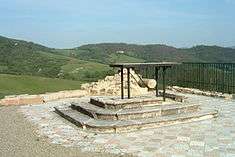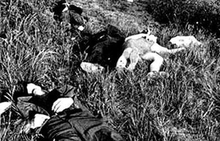Marzabotto massacre
| Marzabotto massacre | |
|---|---|
 Remains of the church of San Martino di Monte Sole | |
| Location | Marzabotto, Italy |
| Date | 29 September - 5 October 1944 |
| Target | Civilians |
Attack type | war crime, mass shooting |
| Deaths | ~ 770 |
| Perpetrators | 16th SS Panzergrenadier Division Reichsführer-SS |
The Marzabotto massacre was a World War II war crime consisting in a mass murder of at least 770 civilians by Nazi troops, which took place in the territory around the small village of Marzabotto, in the mountainous area south of Bologna. It was the largest massacre of civilians committed by the Waffen SS in Western Europe during the war. It is also the deadliest mass shooting in the history of Italy.
Massacre
In reprisal for the local support given to the partisans and the Resistance between 29 September and 5 October 1944, SS-Sturmbannführer Walter Reder led soldiers of the 16th SS Panzergrenadier Division Reichsführer-SS to systematically kill hundreds of people in Marzabotto. They also killed numerous residents of the adjacent Grizzana Morandi and Monzuno, the area of the massif of Monte Sole (part of the Apennine range in the province of Bologna).

Historians have struggled to document the number of victims: some sources report up to 1,830 victims; others estimate 955 people killed. Today, the Peace School Foundation of Monte Sole reports 770 victims. This number is close to the official report by Sturmbannführer Reder, who reported the "execution of 728 bandits". Among the victims, 155 were less than 10 years old, 95 were aged 10 to 16, 142 were over 60 years old, 454 were male and 316 were female.
Giovanni Fornasini, a parish priest and member of the Resistance, risked his life to protect the population from the Nazis during the massacres. While Fornasini saved the lives of many of his parishioners and managed to escape immediate death, while he was burying the bodies of those killed in the massacre (which was forbidden by the Nazis), he was discovered by an SS officer, who accused him of crimes committed in the Marzabotto area. When Fornasini confessed to having helped the villagers avoid execution, the officer shot and killed him.
Justice
- The British tried SS General Max Simon for his part in the massacre. He was sentenced to death, later changed to life in prison. Simon was pardoned in 1954 and died in 1961.
- The Americans arrested SS Major Walter Reder, an Austrian national, in Salzburg, and passed him to the Italians via the British. In 1951 he was tried in an Italian military court in Bologna. He was sentenced to life imprisonment in the military prison at Gaeta. He was released in 1985 and died six years later in 1991.
- In 1998, on the 54th anniversary of the massacre, the German President Johannes Rau made a formal apology to Italy and expressed his "profound sorrow and shame" to the families of the victims of Marzabotto.
- In January 2007, 10 of 17 suspected former SS members were found guilty in absentia by an Italian military tribunal in the north Italian town of La Spezia. They were sentenced to life imprisonment for the massacre. The Italian media reported that the 10 were also ordered to pay roughly €100 million to the survivors and relatives of the victims. Seven suspects were acquitted.[1]
In popular culture
- L'uomo Che Verrà (2009) tells the story of the local Italian people, partisans and the Marzabotto Massacre. It has won numerous awards. It features Raffaele Zabban playing Don Giovanni Fornasini, and Germano Maccioni playing Don Ubaldo Marchioni.
See also
- Giovanni Fornasini (1915-1944), priest, l'angelo di Marzabotto, Gold Medal of Military Valour, Servo di Dio
- Ubaldo Marchioni (1918-1944), priest, Servo di Dio
- Sant'Anna di Stazzema massacre
- Lidice
- Kľak
- Oradour-sur-Glane massacre
- Ochota massacre
- Khatyn massacre
- Italian Campaign (World War II)
- List of massacres in Italy
- German war crimes
References
- ↑ "Italy convicts Nazis of massacre". BBC News. 2007-01-13. Retrieved 2007-01-15.
| Wikimedia Commons has media related to Marzabotto massacre. |
Sources
- Marzabotto: The Crimes of Walter Reder - SS-Sturmbannführer, by Christian Ortner (Vienna, 1985)
- Silence on Monte Sole, by Jack Olsen (New York City, 1968) ISBN 0-213-17794-3
- Don Giovanni Fornasini, Associazione Nazionale Partigiani d'Italia
External links
- Peace School Foundation of Monte Sole, in Italian
- Monte Sole Park, in Italian
- Massacres and Atrocities of World War II
- The Man Who Will Come (L'uomo Che Verra)
Coordinates: 44°18′37″N 11°13′11″E / 44.31028°N 11.21972°E